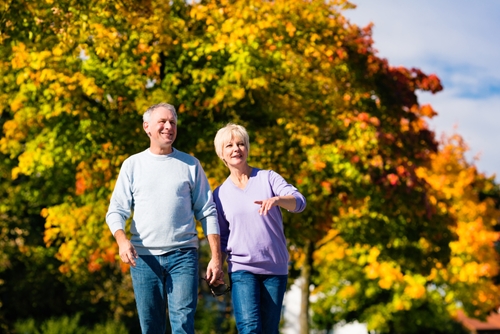How to prevent falls

Risk of injury from falling is one of the biggest challenges seniors face. As we age, we tend to lose strength in our muscles and bones and are more prone to diseases that can leave us weak in the legs, hips and arms. Fluctuations in health throughout life can make it more likely some will fall and end up with a serious injury as a result. According to the Centers for Disease Control and Prevention, one in three seniors will fall, resulting in 2 million hospital visits for fall-related injuries. To keep seniors safe and independent, it is important to take steps to strengthen muscles, improve flexibility and reduce risks of falling in the home.
Senior fitness
Exercise is crucial later in life for staying strong and healthy – and preventing falls. While the CDC recommends that adults get about two hours and 30 minutes of aerobic exercise every week, strength training is another important part of improving muscles. Strength training can also have a beneficial impact on bones, as regular weight-bearing exercises can prevent bone loss and osteoporosis, which can reduce the chance of bones fracturing in a fall.
There are some exercises that are better than others for strengthening muscles and bones. Yoga combines stretching – which increases flexibility – and strength training. In a study by the National Institutes of Health, yoga was found to help seniors reduce their fear of falling and improve balance. In fact, the NIH recommended that fall prevention programs adopt yoga practice into the routine preventive treatments. Tai chi is another form of exercise that utilizes movement with stretching and strength exercises. Both exercises can be beneficial for seniors hoping to better coordinate the body and its movements. Seniors who may be new to these activities should consider looking into a weekly group class.
Senior wellness
There are several other factors in life that can increase the dangers of falling. For example, vision problems can cause a person to misjudge perception and fall. To make sure vision is not an issue, seniors should go in for a vision test annually. Blood pressure changes can also make a person dizzy, which may result in a collapse and injury. Seeing a doctor regularly or annually can reduce these risks. Additionally, using equipment like walkers and canes properly will reduce the odds of a fall. Seniors should also wear shoes and clothing that are well-fitted and have gripping soles.
Steps to take at home
Most falls happen to seniors at home and are largely preventable with a little bit of preemptive action. For instance, making sure homes are well-lit by using brighter light bulbs or positioning lights to better illuminate a room can reduce the chances of bumping into something and losing balance. Night lights in areas like the hallway and bathroom may also be advantageous at night. Clutter in the home can be another major obstacle that can cause a person to fall down and injure themselves. To avoid this hazard, there should be clear, unobstructed pathways in the home. While stairs are unavoidable in many homes, they present a tough challenge and threat to falling for many seniors. Stairways should be well-lit as well, and equipped with handrails on both sides for assistance.
Medication awareness
To combat some diseases, seniors may be taking prescription medications. If this is the case, side effects should be checked to see if certain prescriptions cause dizziness or lightheadedness, as this can increase the chances of losing balance and falling. Seniors should review their medications with their doctor and ask about potential side effects.
Fear of falling
Even without ever having taken a spill, many seniors develop a fear of falling. This might influence some to reduce their physical activities or limit their exercises in order to reduce their chances of falling. However, this can be counter-productive, and limiting exercise can be detrimental to senior wellness. Instead, it is important to stay active. If seniors are very worried about the risks of falling, speaking with a doctor or physical therapist may help find exercises that are safe.
To maximize your Senior Health Insurance benefits, visit MySeniorHealthPlan.com for quick, simple and easy information.

